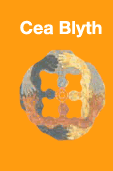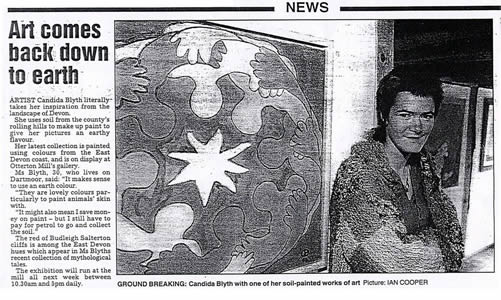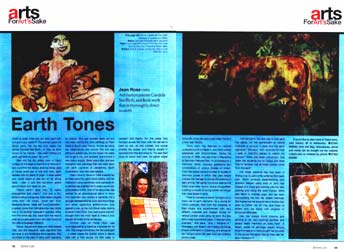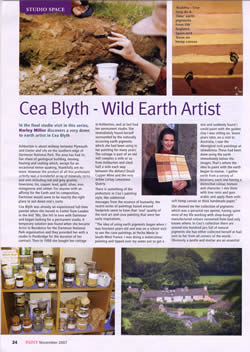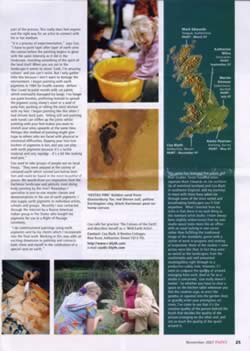PAINTING WITH THE EARTH
Comments and Reviews
"An evocative symbol of the power of togetherness." Said Sarah Kent of Time Out Magazine, and David Thorpe of the South London Gallery on C's first 'hug' painting in '95 (At Cooltan Arts)
"Such beautiful congruence of subject and material."
"Very subtle, peaceful & natural & also very original. I've never seen anything like it! - thank you"
Comments from exhibitions, workshops and residencies, Postbridge 1996
"The real true colours of the place I love - Dartmoor - beautiful" K.A. Princetown
"Glad we crossed the foggy moor to see your sunny paintings'' H.T. Ashburton
Comments from exhibitions, workshops and residencies, Princetown 2000
"Thank you for a interesting, instructive and entertaining day'
"It is so simple it blows my mind."
"It helps you to free up and explore, as it's hard to be contrived or too controlled."
Comments from Workshops
Reviews and Interviews
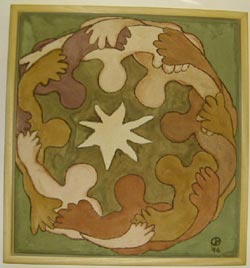
BBC Radio Devon Interview (mp3 download)
The Guardian, see copy '97
Exeter and Exmouth Express and Echo 97
Big Issue 11 '94
Devon Life "Earth Tones" '03
PAINT magazine '07
Country Lives. WMV 9.3mb '04
Pictured right: Earth Love Hug. The green pigment is from Cyprus, all the other pigments are from Dartmoor and Spain. The composition is inspired from a seminar on Family Constellations by Bert Hellinger.
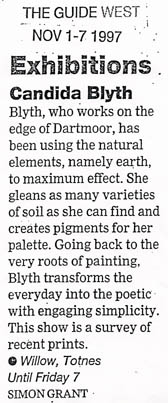
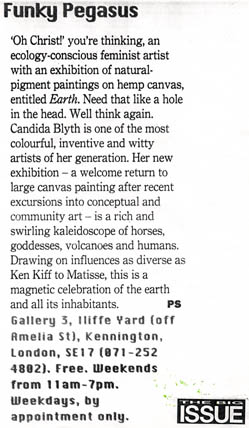
an out-take from the Express and Echo - Click to enlarge
Jean Rose visits Ashburton painter Candida Sea Blyth, and finds work that is thoroughly down to Earth.
Earth Tones
Here's a riddle: what can you both paint with and grow your roses in? The answer: good old devon Earth. For the last nine years, the painter Candida Sea Blyth - or Cea, as she's known to her friends - has used nothing but Earth pigments to colour her work.
Walk into the tiny sitting room in Cea's cottage on the edge of Dartmoor at Ashburton and you'll find the display shelving used to house small jars of soil and rock, each labelled with its place of origin. A large pestle and mortar stand at one end of her dining table. I peer in and find red-brown grains ground down and ready for use.
"Devon earth," says Cea, "is mainly strawberries and cream." And just a tiny amount will go along way. Cea's store includes pinks from old mines, "good red" from Blackpool Sands, "deep red" from Collumpton, a golden ochre from Michelcombe near Holne that is "so exciting" because it sparkles, white from the china clay pits, black from the moors peat and a pale green from soft rock found on the cliffs at Budleigh Salterton.
Colour, texture and place are what interest Cea, and she frequently uses pigments that are local to any landscape she's painting. She stumbled on the idea of using earth pigments by chance. She was fourteen years old and had been visiting the cave paintings at Pech Merle in South-west France. As she sat using her watercolours, she noticed she was sitting on golden clay. So she tipped her water pot to get a mix, and suddenly she'd found a new colour supply. Seven years later, she saw Aboriginal rock paintings that had been done with earth pigments at Jalwabinna, North Queensland. Now she was inspired.
Cea's move to Devon in 1996 enabled her to make use of it's highly varied palette, and her method of using specifically local pigments for a painting has enabled her to create some very personalised works. One of her favourites was painted for an arboriculturist about to move from Scorriton who wanted a memento. It's a strongly represational work showing a large and rather lugubrious golden-brown cow against a view of the Holy Brook valley towards Holne Moor. Cea used a gold pigment brought from the moor itself to make a truly special reminder of the landscape.
Another view of Holne Moor was commissioned by a friend as a surprise for his wife. The foreground shows her favourite spot - a place where the granite forms a natural seat with a view across the Dart valley to Leusdon and Haytor. For this piece, Cea tramped across the moor with her canvas to paint on site. As she worked, two ponies entered the scene, and they're caught in pigments from the land close by. The seat itself takes its colour from the peat, the lighter edges done with china clay and a pale cream found in a lane near Rattery.
Cea's work has featured in national publications and on Radio 4, and she's worked extensively with schoolchildren. During the summer of 1996, she was an Artist in Residence at Dartmoor National Park. I'm impressed by a dartmoor 'tartan' showing gradations and combinations of various shades of brown. From this period came a number of studies of Dartmoor ponies in which Cea used simple outlines that manage to convey the essence of each animal. Her gently humorous take on the Celtic horse deity, Epona, shows the goddess cuddling a couple of young ponies as though they were babes in arms.
There is, however, a darker background to Cea's use of earth pigments. As a young art history graduate, fresh from the University of East Anglia, she experimented with very different materials and created murals for various London Clubs using car paint. But she didn't wear a protective mask. "I reached toxic overload," she says. "and I became ill." Nowadays, she doesn't risk inhaling the fumes of even white spirit or turpentine, and almost all her mixing is done with resin from her mothers almond trees.
Cea has learnt the har way to help save the planet, but her appreciation of natural materials is obvious. "I really love the earth pigments," she says, "and I love the fact that I walk in beautiful places to collect my colours." When she leads workshops, Cea takes her students out on forays and finds they're "amazed that all these colours come from the earth".
Her latest personal test has been in finding how to paint while suffering from back pain. She's currently experimenting with abstract designs using wool or pony hair instead of a brush and working with her feet, pushing and rolling the wool mixture. She's also learnt to practise yoga, and has been incorporating this into her artistic methods. She hopes that her experiences of finding new ways to further her art may give hope to others who are faced with physical or emotional difficulties.
Cea has always found drawing and painting to be very soothing activity and always seeks "harmony on every level". A recent series of paintings based around footprints seems to have brought her full circle to the simple Aboriginal rock art that was early inspiration.
Harley Miller talks with Cea Blyth as part of her studio visit series in PAINT magazine - Click pages to enlarge.
